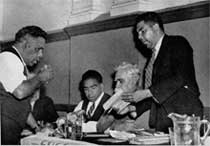Australia's First peoples worse off than 40 years ago
Will Ockenden ABC News 26 January 2012
For many Indigenous Australians, the 26th January 2013 marks the 75th anniversary in the fight for Aboriginal rights and recognition.
In 1938, a large group of Aboriginal people gathered in Sydney at a protest they called the Day of Mourning, which marked 150 years since European settlement.
The Indigenous demonstrators demanded full citizen rights and equality and the protest was the beginning of the organised Aboriginal civil rights movement.
Aged just two-and-a-half years old, Aboriginal elder Esther Carroll was pictured at that first protest.
"I was too young to know what it was all about then," she said.
"When you think of those men who were calling for such civil rights, back in 1938 in the 30s and working on it from then, it was not until 1967 that we were counted in the census.
"We were nothing until then; we were bungled in with the flora and fauna."
She says the cause is just as important now as it was then.
"I listened to a very intelligent Aboriginal man who lives in Melbourne at the moment by the name of Gary Foley and he was around in those days, in the early days of the '60s from the fight for the foundation of Aboriginal affairs," Ms Carroll said.
"And he said 40 years down the track, we are worse off. And I agree with that."
From 1938 onwards, Australia Day has also been a day of protests and gatherings for Indigenous people demanding recognition.
"The word invasion came about at a later time in life, I think, because we're now learning more that we were invaded," Ms Carroll said.
"And one of the things that pushes that home to me is that we're not in the Constitution and until we're written up in the Constitution we are living our life by white man's law."
One of Ms Carroll's neighbours has a huge Australian flag hanging in their window.
She says she has recognised the growth of a more overt expression of Australian nationalism in recent times.
"It wasn't as prominent in the years gone by as it is today and I just think it's competition. I think it is the growth in nationalism - people are capitalising on that," she said.
"I would just rather go and pitch a tent down on the river bank or something and enjoy the day there just boiling the billy, having a good old time and a yahoo or whatever in that way or get together with family and friends. That's how I'd like to spend [Australia Day]."



Click images to expand and view captions
ASHLEY HALL: For many Indigenous Australians, today marks the 75th anniversary of the fight for Aboriginal rights and recognition.
In 1938, a large group of Aboriginal people gathered in Sydney at a protest they called The Day of Mourning.
The Indigenous demonstrators demanded full citizen rights and equality, and the protest was the beginning of the organised Aboriginal civil rights movement.
Will Ockenden reports.
WILL OCKENDEN: Seventy-five years ago today, Esther Carroll was among a large gathering of Aboriginal people in Sydney.
ESTHER CARROLL: I was too young to know what it was all about then, and even younger when I found out that was me on the photograph.
WILL OCKENDEN: The photograph documents the Day of Mourning, a protest in 1938, marking 150 years since European settlement. It was the start of a movement demanding recognition for Aboriginal people, for citizenship and social justice.
Esther Carroll was 2.5 years old that day, and is now one of two people in the picture still alive.
ESTHER CARROLL: Well when you think of those men who were calling for such civil rights, back in 1938 in the 30s and working on it from then, it was not until 1967 that we were counted in the census. So we were nothing until then, we were bunged in with the flora and fauna.
WILL OCKENDEN: From 1938 onwards, the 26th of January has continued to see organised protests and gatherings of Indigenous people demanding recognition.
ESTHER CARROLL: The word invasion came about at a later time in life, I think, because we're now learning more that we were invaded. And one of the things that pushes that home to me is that we're not in the Constitution and until we're written up in the Constitution we are living our life by white man's law.
WILL OCKENDEN: One of Esther Carroll's neighbour's has a huge Australian flag hanging in their window. The trend to a more overt expression of Australian nationalism is something she says she's noticed.
ESTHER CARROLL: It wasn't as prominent in the years gone by as it is today and I just think it's competition. I think it is the growth in nationalism, people are capitalising on that.
I would rather just go and pitch a tent down on the river bank or something, and enjoy the day there just boiling the billy, having a good old time and a yahoo or whatever in that way, or get together with family and friends. That's how I'd like to spend it.
WILL OCKENDEN: Esther Carroll says the Day of Mourning is still as important today as it was 75 years ago.
ESTHER CARROLL: I listened to a very intelligent Aboriginal man who lives in Melbourne at the moment by the name of Gary Foley and he was around in those days, in the early days of the 60s from the fight for the foundation of Aboriginal affairs and he said, 40 years down the track, we are worse off. And I agree with that.
ASHLEY HALL: Aboriginal Elder Esther Carroll, ending Will Ockenden's report.
Prepared and edited by Sovereign Union Volunteers


